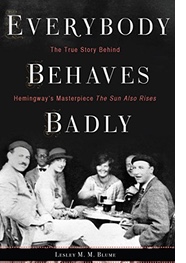Review of Lesley M.M. Blume's “Everybody Behaves Badly: The True Story Behind Hemingway's Masterpiece The Sun Also Rises”
 [The
Sun Also Rises]
is a novel about bullfighting,
bull-slinging, and bullshit.”- Zelda
Fitzgerald
[The
Sun Also Rises]
is a novel about bullfighting,
bull-slinging, and bullshit.”- Zelda
Fitzgerald
In July of 1925 Ernest Hemingway, a would-be novelist seeking a story, led an entourage of his fellow Paris expats (expatriates) to the San Fermin festival in Pamplona, Spain. The group included, besides Ernest and his wife Hadley, Lady Duff Twysden, described as an “idiosyncratic temptress” and a”symbol of breeding”; Harold Loab, a wealthy American and fellow writer; Kitty Cannell, an American journalist and, at that time, Loab's mistress; Donald Ogden Stewart, a fellow writer; Pat Guthrie, “a perpetually drunk Scottish debtor” and, for the Pamplona week, Lady Duff's lover. Also, Bill Smith, a fellow writer who had a “shared boyhood” with Hemingway.
The 1925 visit to the week long San Fermin festival was not Hemingway's first. In July 1923, he and Hadley were among the few American tourists at the Spanish celebration. Hemingway witnessed the “running of the bulls” followed by a bull fight and it was love at first sight. Hadley was less impressed but for Ernest it was “an inspiration.”
Another visit to Pamplona came the following year . Hadley remained in Paris to care for their young son and Papa Hemingway was accompanied by three expat friends: Donald Stewart, Bill Bird, and Robert McAlmon, enticed, less by the festival than by the excellent trout fishing at Buguete, Spain on the Irati River. “We walked on the road between the think trunks of the beeches and sunlight came through the trees.” As with the first visit, details were entered into Hemingway's extensive notebooks.
Drafting of what was to be The Sun Also Rises began immediately upon departing Pamplona in July1925. In mid-August he wrote a friend from his days as a reporter for the Toronto Star about the novel declaring “that it ought to be damned good.” It was up to forty thousand words and he was writing at full speed. He wrote another friend that “It is a hell of a fine novel.”
By the end of his third visit to the Fermin festival (the first title of his first novel was Fiesta, a title retained by the British publisher) what was an extensive reporter's notebookby a former reporter who had mastered that craft before moving on to writing short stories on the way to a novel. His first draft left his main characters identified but soon Hemingway the narrator became Jake Barnes, Harold Loab became Robert Cohn and so on. Who was who was no mystery to members of the 1925 entourage nor to his expat friends and acquaintances in Paris. (Not to be overlooked is the excellent 1954 motion picture of the same name featuring Tyrone Power as Jake Barnes, Ava Gardner as Lady Brett Ashley, Mel Ferrer as Robert Cohn, and Errol Flynn in a masterful performance as Mike Campbell the dissipated Scotsman.)
Led by his writer friend, the very successful novelist, F. Scott Fitzgerald, expats in Paris pressed the venerable publishing house, Charles Scribner, to publish Hemingway. Scribner was wary at first because of racy language and rampant sex. After a few adjustments were made, 5,000 copies of The Sun Also Rises was released in the United States on October 22, 1926. It was an instant success drawing just short of unanimous rave reviews.
The New York Times reviewer exulted in the book's “lean, hard, athletic, narrative prose that puts more literary English to shame.” Another called his style “terse, precise, and aggressively fresh.”
The least enthusiastic reviewers conceded that The Sun Also Rises represented a stylistic tour de force.” This once promising young writer [had] established himself as a young master of modern writing.” Writing that involved “an economy of words,” as one critic offered. His friend, and one of the Pamplona entourage, Donald Stewart, noted, “It was so absolutely accurate [as to their 1925 stay in Pamplona] that it seemed little more than a skillfully done travelogue.” Lady Duff [LadyBrett] declared that “the book was nothing more than an example of 'cheap reporting.' ” The Saturday Review of Books claimed in its review “that the book was more an example of intensive reportage than fictional accomplishment.” As far as Hemingway was concerned “his reporting skills were coming in handy.”
How this “young master,” who had shunned college at eighteen to become a newspaper reporter (at the Kansas City Star) then raced off at nineteen to serve, not as a soldier, but as an ambulance driver and a “very minor sort of camp follower” serving the Italian army is curious. After recovering from serious wounds, he devoted his time, efforts and talent to become a writer of well-received short stories though he was convinced that “the only way to receive the recognition he deserved was to produce a novel.”
And how Ernest Hemingway (1899-1961) achieved that goal and gained the recognition he felt he deserved, is what Everybody Behaves Badly is all about.
HINT: For a better appreciation of how badly the expatriates from Paris acted in Pamplona, Spain in July of 1925, and what happened to those who inspired the principal characters, read or reread The Sun Also Rises.